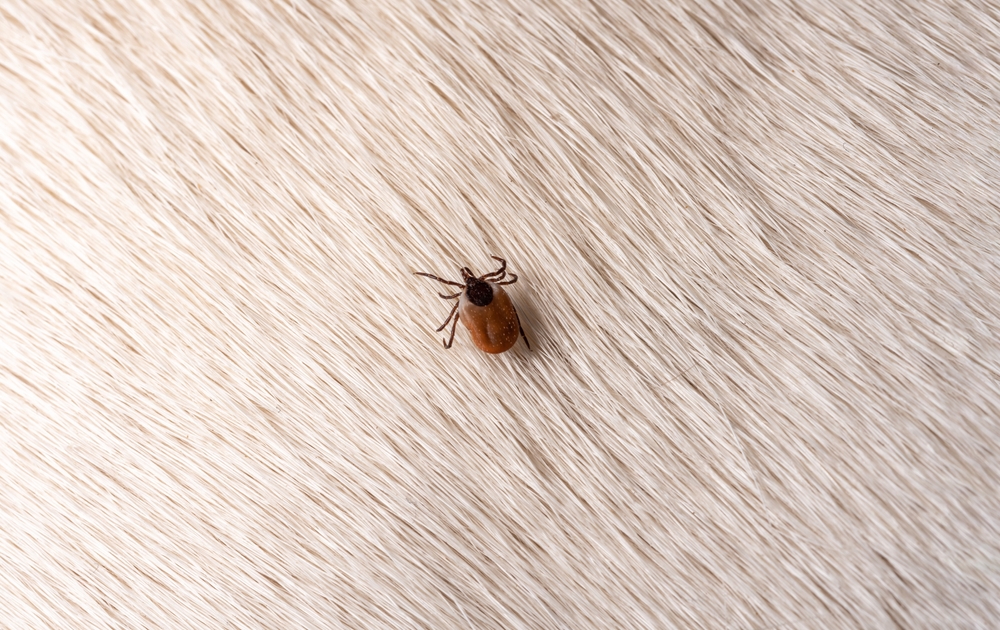The Garden State is known for its beaches, boardwalks, and Borrelia burgdorferi, the bacteria that cause Lyme disease. New Jersey is a known hot-spot for this debilitating tick-borne illness, which can infect human and canine populations. Fortunately, prevention is possible with awareness and appropriate veterinary care.
Before you venture out to enjoy the warm spring and summer weather, check out the following (tick)-bite-sized tips from The Gentle Vet team to help you protect your four-legged friend in the great outdoors.
Infected ticks transmit Lyme disease by biting your dog
Lyme disease is primarily transmitted by the black-legged tick or deer tick (Ixodes scapularis) species, which is well-established in New Jersey, most likely because of our warm and humid spring, tick-friendly habitat (i.e., vegetation, wooded areas), and large deer population. Ticks must consume a blood meal at each stage in their life cycle, and their most common meal targets include small wildlife, rodents, birds, deer, and, when available, pets and humans.
Tick bites and Lyme disease transmission are most common during the warmer months when ticks are most active (i.e., April through October). However, ticks can also emerge on mild winter days.
Cats are considered low risk for Lyme disease
Lyme disease has not been detected in cats outside a laboratory setting and little is understood about why or how cats appear to evade or eliminate this disease. We can assume that clinically affected cats would display similar signs as dogs. And, because Lyme disease is still a potential—albeit unlikely—risk for felines, The Gentle Vet team recommends all cats receive year-round flea and tick preventives.
Lyme bacteria can affect your dog’s joints, kidneys, and nervous system
Once Borrelia burgdorferi bacteria enter your dog’s bloodstream, they travel to far-reaching body systems and areas including the joints, kidneys, nervous system and, in rare cases, the heart. The bacteria cause inflammatory damage resulting in generalized illness (i.e., malaise), chronic arthritis-like pain, and reduced organ function. However, unlike affected humans, only 10% of Lyme disease positive dogs experience clinical illness.
Lyme disease signs in dogs can be vague and intermittent
Lyme disease affected dogs experience a nonspecific group of signs that wax and wane, rather than the iconic bullseye rash associated with infection in humans. Dogs therefore need routine, yearly tick-borne disease screening tests to ensure their Lyme disease does not go completely undetected.
Common Lyme disease signs in dogs include:
- Unexplained limping that shifts from one leg to another, or seems to come and go
- Stiffness
- Joint swelling or palpable pain
- Fever
- Appetite loss
- Lethargy
- Swollen lymph nodes
Prompt veterinary assessment, diagnosis, and treatment can alleviate your dog’s discomfort and minimize permanent injury. In some cases, delayed intervention can lead to irreversible kidney or joint damage that requires lifelong supportive care or medication.
Lyme disease diagnosis for pets
If your veterinarian suspects Lyme disease, they will first rule out other health conditions to confirm infection. This process generally includes:
- Patient history — Asking key questions about your pet’s lifestyle, signs, and preventive use
- Physical examination — Examining your pet thoroughly, looking for visual or palpable changes
- Lyme disease testing — Screening and measuring Lyme antibodies (i.e., proteins) in your pet’s blood
- Additional diagnostics — Recommending complete blood work, urinalysis, X-rays, and ultrasound, if necessary
Lyme disease is often found incidentally and diagnosed in asymptomatic dogs during their annual heartworm and tick-borne disease screening test. Monitoring is generally recommended unless your dog begins showing Lyme disease signs.

Lyme disease treatment for pets
Borrelia burgdorferi bacteria respond well to tetracycline antibiotics (e.g., doxycycline and minocycline). Antibiotic regimens must be administered for at least 30 days to ensure complete bacteria eradication, and prescription directions must be strictly followed to avoid prolonging the pet’s suffering or disease progression. Despite the pet’s rapid improvement (i.e., one to three days) after starting antibiotic therapy, owners must continue to administer all the medication. All pets must be placed on year-round tick preventives, since Lyme disease does recur. Pets with Lyme disease-related complications, such as kidney insufficiency or inflammatory joint changes, may require additional care or life-long supportive therapy.
Keeping the greatness in the great outdoors—preventing Lyme disease in pets
Don’t let Lyme disease fears keep you and your four-legged friend from enjoying outdoor adventures, because a comprehensive prevention plan is all you need to ensure their safety and your peace of mind.
- Year-round tick prevention — Protect your pet from ticks and fleas with a veterinarian-recommended preventive from The Gentle Vet. Ensure you dose your pet according to product directions (i.e., every 30 or 90 days) to avoid coverage gaps.
- Lyme disease vaccination for dogs — Active dogs who frequently spend time in tick habitats (e.g., woods, grassy fields) should be vaccinated against Lyme disease in addition to year-round preventives.
- Environmental tick control — Reduce ticks around your home by keeping grass trimmed, removing leafy debris, and relocating wildlife feeders.
Although veterinary tick and flea preventives provide a rapid speed-of-kill (i.e., between four to eight hours before disease transmission can occur), these products do not repel ticks. Therefore, you could possibly find a live or crawling tick on your pet, so always check after playing outdoors in wooded or grassy areas, and remove any crawling or attached ticks to further minimize infection risk.
If you’re feeling ticked off about Lyme disease, stay calm and contact The Gentle Vet for personalized parasite preventive recommendations. Also, contact our team to discuss your pet’s tick and other parasite prevention needs.








Leave A Comment